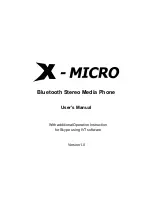
D-Link Systems, Inc.
Glossary
64
DVC-2000 User’s Manual
IP address (Internet Protocol Address):
An IP address is a number that identifies a
computer connected to the Internet. Every computer that is connected to the Internet
must have a unique IP address. An IP address consists of four sections separated by
periods. Each section contains an 8-bit value represented as a number ranging from 0
to 255.
ISP (Internet Service Provider):
A commercial organization that provides subscribers
with access to the Internet.
LAN (Local Area Network):
A network that is designed to span small distances. These
are most commonly used in small buildings, businesses and homes with multiple PCs.
See WAN.
NAT (Network Address Translation):
A technology that allows multiple network devices
to share the same IP address. NAT devices forward all incoming and outgoing
information to the correct network devices. Most NAT devices have firewall capabilities.
Port Forwarding:
The router will forward public-side incoming information to a specified
device on the private side. The router will forward only the data that is received on the
specified ports. This is usually set through the advanced settings in the router’s web
interface. Also known as
Virtual Server
or
Firewall Rules.
Ports:
A port is a specified path in which data travels. Each type of data that is transmitted
over the Internet travels down a specified port. A router will forward information from
one port to another, and a firewall will open only a specified number of ports.
Private IP address:
An IP address that is behind a NAT, which is not visible to the
Internet. The preferred ranges for private IP address are either 192.168.x.x or 10.0.0.x.
Public IP address:
An IP address that is not behind a NAT router. This IP address is
visible from the Internet.
QCIF (Quarter Common Intermediate Format):
An intermediate video format. QCIF
resolution is 176x144. The DVC-2000 VideoPhone will send QCIF-sized video only if
the remote endpoint cannot decode CIF.
QoS (Quality of Service):
Allows guaranteed bandwidth and packet delivery between
network devices over a network.
Router:
A device that attaches two or more network devices and forwards data
accordingly. Most consumer type routers act as DHCP servers, NATs and firewalls.
SLIC (Subscriber-Line Interface Circuit):
Provides a phone’s analog dial tone, busy
tone, dual-tone multiple-frequency (DTMF) generation and decoding, caller ID and ring-
signaling functions. The SLIC allows the DVC-2000 to work with a standard telephone
without connecting to the phone system.
SQCIF (Subquarter Common Intermediate Format):
An intermediate video format.
SQCIF resolution is 128x96. The DVC-2000 VideoPhone will send SQCIF-sized video
only if the remote endpoint cannot decode CIF or QCIF.












































